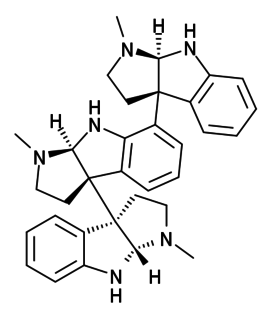
Alkaloids are a class of naturally occurring organic compounds that mostly contain basic nitrogen atoms. This group also includes some related compounds with neutral and even weakly acidic properties. Some synthetic compounds of similar structure may also be termed alkaloids. In addition to carbon, hydrogen and nitrogen, alkaloids may also contain oxygen, sulfur and, more rarely, other elements such as chlorine, bromine, and phosphorus.

Aconitine is an alkaloid toxin produced by the Aconitum plant, also known as devil's helmet or monkshood. Monkshood is notorious for its toxic properties. In China, aconitine is also used in small doses as an analgesic and blood coagulant.

Ephedra is a medicinal preparation from the plant Ephedra sinica. Several additional species belonging to the genus Ephedra have traditionally been used for a variety of medicinal purposes, and are a possible candidate for the Soma plant of Indo-Iranian religion. It has been used in traditional Chinese medicine for more than 2,000 years. Native Americans and Mormon pioneers drank a tea brewed from other Ephedra species, called "Mormon tea" and "Indian tea".

Ergoline derivatives comprise a diverse group of chemical compounds whose structural skeleton is the alkaloid ergoline. Ergoline derivatives are used clinically for the purpose of vasoconstriction (5-HT1 receptor agonists—ergotamine) and in the treatment and alleviation of migraines (used with caffeine) and Parkinson's disease. Some ergoline alkaloids found in ergot fungi are implicated in the condition ergotism, which causes convulsive and gangrenous symptoms. Others are psychedelic substances, including LSD and some alkaloids in Argyreia nervosa, Ipomoea tricolor and related species.

Yohimbine, also known as quebrachine, and not to be confused with yohimbe, is a indoloquinolizidine alkaloid derived from the bark of the African tree Pausinystalia johimbe; also from the bark of the unrelated South American tree Aspidosperma quebracho-blanco. Yohimbine is an alpha-2 adrenergic antagonist, and has been used in a variety of research projects. It is a veterinary drug used to reverse sedation in dogs and deer. While yohimbine behaves as an aphrodisiac in some mammals, it does not do so in humans. It has been prescribed as a treatment for erectile dysfunction, but its reported clinical benefits were modest and it has largely been superseded by the PDE5 inhibitor class of drugs. Substances which have purported to be extracts from the yohimbe tree have been marketed as dietary supplements for various purposes, but they contain highly variable amounts of yohimbine, if any; no published scientific evidence supports their efficacy.

Batrachotoxin (BTX) is an extremely potent cardiotoxic and neurotoxic steroidal alkaloid found in certain species of beetles, birds, and frogs. The name is from the Greek word βάτραχος, bátrachos, 'frog'. Structurally-related chemical compounds are often referred to collectively as batrachotoxins. It is an extremely poisonous alkaloid. In certain frogs this alkaloid is present mostly on the skin. Such frogs are among those used for poisoning darts. Batrachotoxin binds to and irreversibly opens the sodium channels of nerve cells and prevents them from closing, resulting in paralysis. No antidote is known.

Argyreia nervosa is a perennial climbing vine native to the Indian subcontinent and introduced to numerous areas worldwide, including Hawaii, Africa, and the Caribbean. Though it can be invasive, it is often prized for its aesthetic and medicinal value. Common names include Hawaiian baby woodrose, adhoguda अधोगुडा or vidhara विधारा (Sanskrit), elephant creeper and woolly morning glory. Its seeds are known for their powerful entheogenic value, greater or similar to its varieties from Convolvulaceae family, with the users reporting significant psychedelic and spiritual experiences. The two botanical varieties are A. n. var. nervosa described here, and A. n. var. speciosa, which are used in Ayurvedic medicine and have great medicinal values.

Several alkaloids that function as monoamine oxidase inhibitors (MAOIs) are found in the seeds of Peganum harmala, as well as tobacco leaves including harmine, harmaline, and harmalol, which are members of a group of substances with a similar chemical structure collectively known as harmala alkaloids. These alkaloids are of interest for their use in Amazonian shamanism, where they are derived from other plants. The harmala alkaloid harmine, once known as telepathine and banisterine, is a naturally occurring beta-carboline alkaloid that is structurally related to harmaline, and also found in the vine Banisteriopsis caapi. Tetrahydroharmine is also found in B. caapi and P. harmala. Dr. Alexander Shulgin has suggested that harmine may be a breakdown product of harmaline. Harmine and harmaline are reversible MAOIs of the MAO-A isoform of the enzyme, and can stimulate the central nervous system by inhibiting the metabolism of monoamine compounds such as serotonin and norepinephrine.
Harmine, also known as banisterine and as telepathine, a fluorescent harmala alkaloid belonging to the beta-carboline family of compounds. It occurs in a number of different plants, most notably the Middle Eastern plant harmal or Syrian rue and the South American vine Banisteriopsis caapi. Harmine reversibly inhibits monoamine oxidase A (MAO-A), an enzyme which breaks down monoamines, making it a RIMA. Harmine selectively binds to MAO-A but does not inhibit the variant MAO-B.

Noscapine is a benzylisoquinoline alkaloid, of the phthalideisoquinoline structural subgroup, which has been isolated from numerous species of the Papaveraceae family. It lacks significant hypnotic, euphoric, or analgesic effects affording it with very low addictive potential. This agent is primarily used for its antitussive (cough-suppressing) effects.

Mitragynine is an indole-based opioid-receptor agonist and the most abundant active alkaloid in the plant Mitragyna speciosa, commonly known as kratom and biak-biak. Dry kratom leaf contains roughly 1.2–2.1% mitragynine.

Voacangine is an alkaloid found predominantly in the rootbark of the Voacanga africana tree, as well as in other plants such as Tabernanthe iboga, Tabernaemontana africana, Trachelospermum jasminoides and Ervatamia yunnanensis. It is an iboga alkaloid which commonly serves as a precursor for the semi-synthesis of ibogaine. It has also been demonstrated in animals to have similar anti-addictive properties to ibogaine itself.

Coptisine is an alkaloid found in Chinese goldthread, greater celandine, and opium. Famous for the bitter taste that it produces, it is used in Chinese herbal medicine along with the related compound berberine for digestive disorders caused by bacterial infections.

Laudanosine or N-methyltetrahydropapaverine is a recognized metabolite of atracurium and cisatracurium. Laudanosine decreases the seizure threshold, and thus it can induce seizures if present at sufficient threshold concentrations; however such concentrations are unlikely to be produced consequent to chemodegradable metabolism of clinically administered doses of cisatracurium or atracurium.

Hodgkinsine is an alkaloid found in plants of the genus Psychotria, particularly Psychotria colorata, although it is also found in Psychotria lyciiflora and probably other species in this family, as well as in the related species Calycodendron milnei.
The molecular formula C19H23N3O2 (molar mass : 325.41 g/mol) may refer to:

Reticuline is a chemical compound found in a variety of plants including Lindera aggregata, Annona squamosa, and Ocotea fasciculata. It is based on the benzylisoquinoline structure.

Corynanthine, also known as rauhimbine, is an alkaloid found in the Rauvolfia and Pausinystalia genera of plants. It is one of the two diastereoisomers of yohimbine, the other being rauwolscine. It is also related to ajmalicine.

N-Methylserotonin is a tryptamine alkaloid. Chemically, it is a derivative of serotonin in which a methyl group resides at its alkyl amine. It is also called Nω-methylserotonin (Nω-methyl-5-hydroxytryptamine) to distinguish it from tryptamine-derived compounds in which a methyl group is bonded to the nitrogen atom of the indole group.

Parasenecio hastatus is a flowering plant species in the genus Parasenecio found in China and East Asia. It contains toxic pyrrolizidine alkaloids.




















